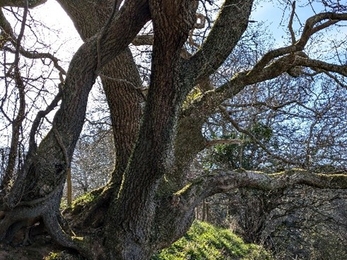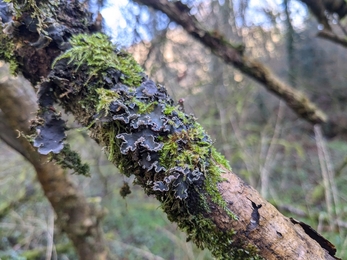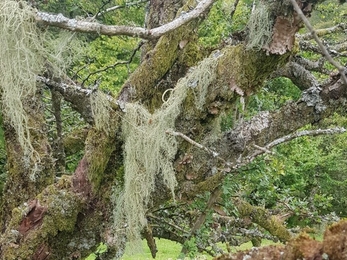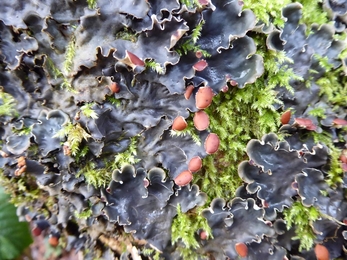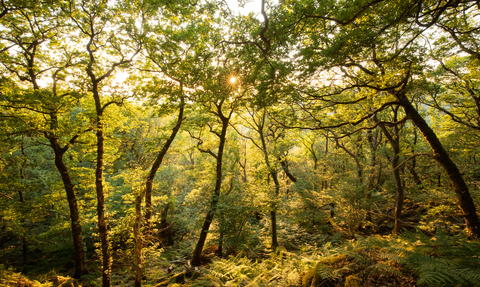
Image by Ben Porter
Temperate Rainforest Restoration Project
Cornwall Wildlife Trust is working to restore internationally important temperate rainforest habitat at West Muchlarnick Farm, near Looe - thanks to a long-term partnership with Aviva.
Located in the humid West Looe Valley, the 150 acre site comprises mostly grassland fields. However, along damp stream-sides, small fragments of ancient temperate rainforest remain. The abundance of epiphytes – lichens, mosses, liverworts and ferns, cloaking the tree trunks, branches and twigs – indicate that these woodland remnants have remained unchanged for hundreds of years.
West Muchlarnick is an ideal location for restoring lost temperate rainforest. It has escaped agricultural intensification, remaining free of artificial fertilisers and pesticides and retaining its ancient hedgerows and green lanes. There are large numbers of veteran trees, which, together with remaining woodland, provide a refuge for species like rare lichens and invertebrates, lost from the wider landscape. This includes 19 species of lichen that the UK has an international responsibility to conserve, because of their rarity elsewhere in the world. However, the fragmented nature of the habitat makes them particularly vulnerable to threats like climate change.
Thanks to a long-term commitment to nature-based solutions by Aviva, we have been able secure support for a 50-year project to restore this rare and threatened ecosystem, through a combination of planting native trees, allowing for natural regeneration, and protecting native species. The restoration is part of the £38 million UK-wide Temperate Rainforest Restoration Programme funded by Aviva to remove carbon from the atmosphere and help nature recover. In addition, this work will have wider benefits for local communities, including reducing flood risk, improving water quality and providing opportunities for volunteering and tourism.

What are temperate rainforests?
Temperate rainforest is a globally rare habitat, occurring in temperate latitudes with high rainfall, and mild, humid conditions all year-round. Only 1% of the world’s surface has a suitable climate, but it is estimated that around 20% of the UK’s climate is suitable.
The gulf stream and prevailing south-westerly winds bring conditions that are perfect for moisture-loving plants and wildlife. Native trees like sessile oak, rowan and hazel are characteristically clad in a lush growth of lichens, mosses and ferns. These woods also support a rich array of rare fungi, insects, woodland birds and mammals. Temperate rainforests typically have a mix of open space and closed canopy, with sunny glades and areas of dappled sunlight reaching tree trunks and the forest floor, where rare lichens and mosses grow. Many of the characteristic species take hundreds of years to establish in an area and they are vulnerable to change. Therefore, the best temperate rainforest sites are ancient woodlands that have had stable conditions for centuries.
Only small fragments now remain, with less than 1% of the British Isles occupied by this special ecosystem. Much was destroyed for timber, agriculture and development, and it continues to be under threat from air pollution, climate change, invasive species and inappropriate management.
Temperate rainforest at West Muchlarnick
With its climate strongly influenced by the sea, large areas of Cornwall would once have been covered by temperate rainforest , hosting amazing biodiversity. We are working to restore this magical and important habitat at our site in West Muchlarnick, near Looe. We are also looking to work with landowners in the West Looe catchment, to encourage restoration across the wider landscape.
Left as a legacy to Cornwall Wildlife Trust in the early 2000s with a wish that the land would be used to benefit wildlife, West Muchlarnick Farm currently consists mainly of modified grassland, with areas of lowland meadow, ancient hedgerows, veteran trees and small fragments of temperate rainforest. This project will see temperate rainforest expand across the site, through a mix of natural regeneration and planting.
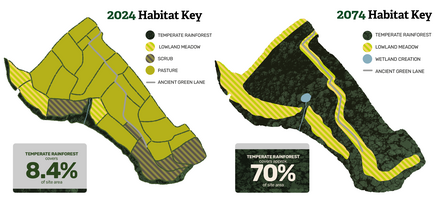
Current coverage of rainforest in 2024 compared to planned coverage in 50 years. Credit to Lou Jones Design
Cornwall Wildlife Trust only uses sites for temperate rainforest restoration where there are limitations for food production, actively avoiding using grade 1 or 2 agricultural land; West Muchlarnick comprises grade 3 and 4.
Survey work at the site has already identified a number of rare and important species, including the ‘floury dog lichen’, Peltigera collina, and ‘string-of-sausages lichen’, Usnea articulata.
As well as temperate rainforest and veteran trees, West Muchlarnick has areas of species-rich grassland. These will be retained as meadow, as part of the rich mosaic of habitats at the site.
What are lichens, mosses and liverworts?
The UK’s temperate rainforests are one of the most diverse habitats for lichens. home to many rare and threatened species.
Lichens are not a single organism. They are ‘composite organisms’, made up of at least two different life forms; a fungus, which provides the external structure and stable living environment, and a photosynthetic partner – usually an alga – that provides food. Scientists have also found that lichens contain yeasts and other bacteria living within.
They can be seen as keystone species in temperate rainforest, making up a substantial part of the biomass, providing food and shelter for many different creatures. Lichens also contain many chemical compounds, which play a role in defence and protection. Of the small proportion of these compounds that have so far been studied, many have been found to have anti-microbial, anti-inflammatory and anti-cancer properties.
Mosses and liverworts are plants. They are sometimes referred to as ‘primitive’ plants because they were among the first plants to colonise land, and they lack roots and vascular tissues for transporting water. Instead they absorb moisture directly from the air around them, and from rain and dew on their leaves and stems. As they do not need roots, they are important colonisers, able to grow on bare bark and rock.
They play an important role in the ecosystem, storing water and regulating microclimate, as well as providing food and shelter for many different species. Along with lichens, they are also thought to play an important role in carbon sequestration.
The UK is a biodiversity hotspot for mosses and liverworts, being home to over half of Europe’s species.
Latest updates
- Winter 2024-2025: Temperate Rainforest Appeal raised £67,000 to kickstart the project, thanks to generous donations from the public, major donors and corporate partners.
- April 2025: Aviva provide support for a 50-year temperate rainforest restoration project at West Muchlarnick, securing the long-term funding needed to plan, develop and manage new temperate rainforest habitat across the 150 acre site.
- July 2025: Submitted an application to the Forestry Commission for the first 5 hectares of woodland creation.
- Current: We are carrying out extensive survey work and consultation, to form a woodland creation plan for the rest of the site. This will enhance existing biodiversity and enable us to create a rich rainforest habitat for the future, whilst retaining the important habitats and species already present (e.g. grassland species).
- Coming soon: We will be beginning a programme of events including guided walks, volunteering and tree planting days as the project progresses, engaging local schools and the community.
Want to get involved or find out more?
Please get in touch by contacting our Temperate Rainforest Project Manager, Alison Smith.


